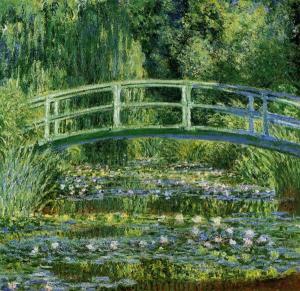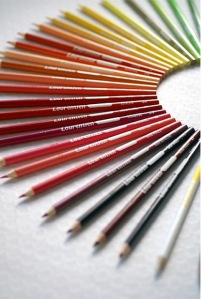How to Copyright Your Art
If you don’t remember, I blogged about copyright issues you might encounter as an artist in a post about Keeping Your Artwork Copyrighted. In that post I mentioned the best way to keep the online artwork you share yours is by watermarking your images. Since this is such an important issue, you should know how to watermark your art in the most simple (and free) way possible.
Extra: see below cut for screencast ‘how-to’ video.
The Use of Sound in Art

You may need Monet‘s Water Lily Pond for the full effect.
Here’s an unconventional topic: how do you think sound fits with art? Some think art is only about the visual aspect, but it’s not. Sound plays with art in two completely different ways.
To truly understand the impact sound has on art, please listen to this podcast: Art and Sound
(What do you hear when you look at Monet’s famous Water Lilies?) Read More…
Improving Your Skills by Visiting Art Museums

Claude Monet, Reflections of Clouds on the Water-Lily Pond, c. 1920, 200 × 1,276 cm (78.74 × 502.36 in), oil on canvas, Museum of Modern Art, New York City (Photo credit: Wikipedia)
For any artist – one way to improve your skills is to learn from the ‘masters’. To many, this means visiting art museums regularly to study and sometimes mimic other artist’s work. Whenever I visit a new city, I’m sure to visit their local art museums – every city will have different, unique works on display that can sometimes lead to some rather interesting inspiration. Visiting art museums is an easy way of making your own art class.
You’ll need to bring:
Online Art Sharing Using Pinterest
 If you’re an artist, an online presence is necessary, but you might be struggling with how to share your artwork online. I’ve talked about using twitter as a promotional tool, but there’s a new social medium you may be unfamiliar with that’s perfect for you: Pinterest.
If you’re an artist, an online presence is necessary, but you might be struggling with how to share your artwork online. I’ve talked about using twitter as a promotional tool, but there’s a new social medium you may be unfamiliar with that’s perfect for you: Pinterest.
Keeping Your Art, Well… Yours
The biggest issue facing you and every other artist is how to make sure your work stays yours, or in general terms: copyright.
You spend hours, days, and months even, making your art – you don’t just want to give it away for free. And when you put your images up on your website, they becomes extremely accessible. Despite being under copyright from the start, people can, and will, try to steal your artwork and claim it as their own. There’s no simple way of stopping them taking your art. You can, however, be vigilant.
Being vigilant includes two simple steps: Read More…
What About Your Privacy?
I recently did a post on twitter and its usages amongst professional artists. However, putting yourself on social media platforms also comes with downsides. One of these downsides is online privacy.
As an artist, you should be used to less privacy because your artwork itself is an expression of who you are and the experiences you have. However, there are two sides to this privacy issue. Firstly, you need to be safe, and second, you need to appear professional. Read More…
Should You Be Using Twitter?
Are you an artist? Yes? Good. Do you have a twitter account to promote your art? No? Stop right there – you should.
Twitter has become such a large part of a person’s social presence on the web. Many artists will know that having a website is essential, but the answer to whether or not you, as an artist, should be using Twitter is a different story. Let me persuade you that twitter can help you for two main reasons: Publicity and Relationships (but mostly publicity). Read More…
Beginning Suggestions for Coloured Pencil Users
If you are a beginning coloured pencil artist, here are two suggestions when considering which brand to buy. (Even experienced coloured pencils artists can benefit from these suggestions – if you haven’t tried other brands recently, you might consider looking again as many formulas have changed.) (How are they made? Check it out.)
First: Try each type/brand of pencil.
 Until you try each brand, you’ll never know which one you find the easiest to use. Many artists will complain about large sets of coloured pencils being fairly expensive, but most art stores carry individual pencils (in coloured pencil terms: open-stock), or very small sets. You can pick up a pencil or two in each type to test them before you decide what set you will stick with.
Until you try each brand, you’ll never know which one you find the easiest to use. Many artists will complain about large sets of coloured pencils being fairly expensive, but most art stores carry individual pencils (in coloured pencil terms: open-stock), or very small sets. You can pick up a pencil or two in each type to test them before you decide what set you will stick with.
Most professional coloured pencil artists have a preferred brand, but will keep several sets of different brands so they have options to choose from. Keep in mind that all coloured pencils are compatible with each other so you don’t have to stick to one brand for a specific painting, which means any coloured pencil purchase will not go to waste.
Once you have decided which brand you will prefer you will want a larger set. Again, yes, the large sets are expensive. However, you will want the extra colours to choose from (to make layering to achieve exotic colours possible), and once you have a set you can always replace the pencils you are using the most from open-stock.
Second: Don’t cheap out.
 This may sound snobby to you, but it’s true. Many beginner artists will choose the cheapest set of coloured pencils they can find so they can “try their hand at it” and they end up discouraged. The reason is simple – cheap coloured pencils can not hold their own against the professional quality pencils. (Interested in knowing the difference? Check it out.)
This may sound snobby to you, but it’s true. Many beginner artists will choose the cheapest set of coloured pencils they can find so they can “try their hand at it” and they end up discouraged. The reason is simple – cheap coloured pencils can not hold their own against the professional quality pencils. (Interested in knowing the difference? Check it out.)
Cheap pencils will blend improperly, scratch your paper, sharpen poorly and have lackluster colour. When any of these problems occur, beginning artists will find their painting turns our poorly and believe it’s because of their inexperience they cannot produce a quality product. Because they feel this simple medium may be too much work, or they believe they will not be able to produce a quality product, they give up; when, in fact, if they had used a professional product, the results could have been much different.
You could almost say “the artist is only as good as his tool”. Quality pencils will blend and layer, producing unique colours that the artist intended.
So, although the quality sets can run you anywhere from $100-$500 (or for special editions, much more), don’t be discouraged – coloured pencils do last a very long time. When you number-crunch, a dollar or two dollars for a pencil is not too much when you consider the pencil can last you many paintings. Coloured pencils may be one of the cheapest dry-media available. (Consider professional pastels which can run from $1.50-$7+ for a single stick, compared to coloured pencils which can run from $1-$4 per pencil and last longer than a pastel would.)
I hope this information was useful to you as you consider purchasing coloured pencils. If you have other important suggestions you think artists should consider, please let me know. If you want more information, some clarification, or ideas for another post, please feel free to leave a comment. (I’d also love to hear from you if you enjoyed this post or not!)





